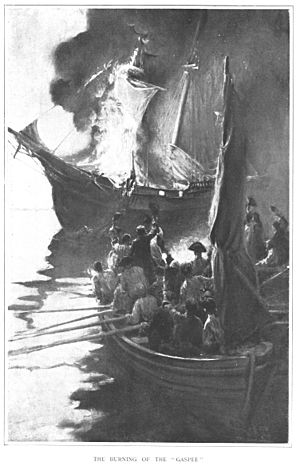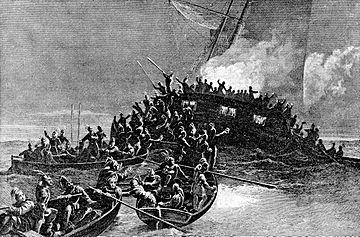Gaspee Affair facts for kids
Quick facts for kids Gaspee Affair |
|||||||
|---|---|---|---|---|---|---|---|
| Part of the events in the lead-up to the American Revolutionary War | |||||||
 Burning of HMS Gaspee |
|||||||
|
|||||||
| Belligerents | |||||||
| Commanders and leaders | |||||||
| Abraham Whipple John Brown |
William Dudingston (WIA) | ||||||
| Casualties and losses | |||||||
| None | HMS Gaspee captured and burned | ||||||
The Gaspee Affair was a big event that helped lead to the American Revolution. In 1772, a British ship called HMS Gaspee was patrolling near Newport, Rhode Island. Its job was to make sure colonists followed British trade rules called the Navigation Acts.
On June 9, the Gaspee was chasing another ship called the Hannah. It got stuck in shallow water near Gaspee Point in Warwick. A group of colonists, led by Abraham Whipple and John Brown, saw their chance. They attacked the ship, boarded it, and set it on fire.
This event made the colonists and British officials even more angry with each other. Tensions were already high after the Boston Massacre in 1770. British officials wanted more control over trade to collect more money. But Rhode Islanders were upset about new British taxes and rules. These included the Stamp Act and the Townshend Acts. Rhode Island had a history of making rum and other sea-based businesses. The new rules caused problems for them.
The Gaspee Affair was one of the first times colonists used violence against British rule in America. It happened over a year before the Boston Tea Party. This event helped push the Thirteen Colonies closer to fighting for their independence.
Contents
Why Were Colonists Upset?
For a long time, colonists had resisted British customs rules. Britain had been at war a lot. So, they didn't want to upset their colonies too much. After Britain won the Seven Years' War, things changed. New British leaders wanted to control the colonies more. They also wanted the colonies to help pay for the war.
Britain bought several ships for customs duty. One of these was the Gaspee. British leaders said they needed money for defense. They also needed to pay off their war debts. So, they made British navy officers enforce customs laws in American ports.
These enforcements became very strict in Narragansett Bay. Rhode Islanders fought back. They attacked a ship called HMS St John in 1764. They also burned the customs ship HMS Liberty in 1768. This happened on Goat Island in Newport harbor.
The Gaspee Arrives
In early 1772, Lieutenant William Dudingston brought HMS Gaspee to Rhode Island. His job was to collect customs taxes and inspect cargo. He arrived in February and met with Governor Joseph Wanton.
Soon, the Gaspee started stopping ships. On February 17, it stopped a ship called Fortune. The Gaspee seized 12 barrels of rum that hadn't been declared. Dudingston sent the Fortune and the rum to Boston. He thought colonists would take back anything left in Rhode Island.
Sending the ship to Boston made Rhode Islanders furious. Dudingston had decided where the trial for the seized rum would be. He ignored Governor Wanton's authority. This also broke the Rhode Island Royal Charter of 1663. That charter said trials for arrests in the colony had to happen in Rhode Island.
Growing Anger
After this, Dudingston and his crew became even more aggressive. They searched, boarded, and seized ships often. They even stopped merchants on land to search their goods. People's anger against the Gaspee and the British grew.
A local sheriff threatened to arrest Dudingston. His boss, Admiral Montagu, responded with a letter. He threatened to hang anyone who tried to rescue ships seized by Dudingston.
On March 21, Rhode Island's Deputy Governor Darius Sessions wrote to Governor Wanton. He asked for Dudingston's authority to be checked. Sessions included the opinion of Chief Justice Stephen Hopkins. Hopkins said no ship commander had the right to act in the colony without first talking to the Governor. Governor Wanton wrote to Dudingston the next day. He demanded to see Dudingston's official papers. Dudingston sent a rude reply. He refused to leave his ship or respect Governor Wanton's authority.
The Attack!

On June 9, the Gaspee was chasing the ship Hannah. But the Gaspee ran aground in shallow water. This happened on the northwest side of the bay, near what is now Gaspee Point. The crew couldn't free the ship. Dudingston decided to wait for high tide to float it again.
But before that could happen, a group of men from Providence decided to act. They saw a chance to end the trouble the Gaspee caused. They rowed out to the ship. They boarded it at dawn on June 10. The crew tried to fight back a little. They were attacked with handspikes. Lieutenant Dudingston was shot and wounded in the leg.
The attackers calmly read the ship's papers. Then, they forced the crew off the ship. Finally, they set the Gaspee on fire.
What Happened After the Attack?
A few days after being forced off his ship, Dudingston was arrested. A sheriff arrested him for seizing colonial cargo earlier. Admiral Montagu, Dudingston's commanding officer, paid his fine. He then sent Dudingston back to England for a military trial about the incident.
Joseph Bucklin was the man who shot Lt. Dudingston. Other men involved included John Brown's brother Joseph, Simeon Potter, and Robert Wickes. Most of these men were also part of the Sons of Liberty.
Earlier attacks by colonists on British ships had not been punished. But in 1772, the British navy would not ignore the destruction of one of its ships. British officials investigated. They looked into legal options. The King decided to use a special investigation called a Royal Commission of Inquiry. This group included important judges and Governor Joseph Wanton.
A new law had been passed saying anyone suspected of burning British ships should be sent to England for trial. The Gaspee attackers were charged with a very serious crime against the king. The commission's job was to find enough evidence to send colonists to England for trial. But the commission could not find enough evidence. They said they couldn't handle the case.
Even so, American colonists who supported independence were worried. The idea of Americans being sent to England for trial was alarming. A special group called a committee of correspondence was formed in Boston to discuss the problem. In Virginia, the House of Burgesses was so worried that they also formed a committee. These committees helped different colonies talk to each other.
A minister named John Allen gave a sermon in Boston. He used the Gaspee affair to warn people about greedy kings and corrupt officials. This sermon was printed many times. It became one of the most popular pamphlets in the colonies. This pamphlet and newspaper articles woke up colonists in 1772. This started a series of conflicts that led to the Battles of Lexington and Concord.
Lasting Impact
The British demanded that the people who shot Dudingston and destroyed the Gaspee be caught and tried. Rhode Island Governor Wanton and Deputy Governor Sessions agreed with the British. But they weren't very eager to punish their own people.
A British officer from the Gaspee said the attackers were "merchants and masters of vessels." Admiral Montagu wrote to Governor Wanton. He used the story of Aaron Briggs, a servant who claimed to be part of the attack. Montagu named five Rhode Islanders he wanted Governor Wanton to investigate. These included John Brown, Joseph Brown, Simeon Potter, Dr. Weeks, and Richmond.
Governor Wanton looked into Aaron Briggs's claims. The owners of the farm where Briggs worked said he was there all night. Two other servants also said Briggs was present. So, Governor Wanton believed Briggs was lying. Dudingston and Montagu disagreed. Montagu said it was clear Briggs was telling the truth.
Today, Pawtuxet Village celebrates the Gaspee affair every year. This festival is called Gaspee Days. It includes arts and crafts and races. The main event is the Gaspee Days parade. It features burning a model of the Gaspee and a battle reenactment.
Gaspee Point is listed as a historic place. There is also a plaque in Providence, Rhode Island. It marks the spot of the Sabin Tavern, where the plan to burn the Gaspee was made.

